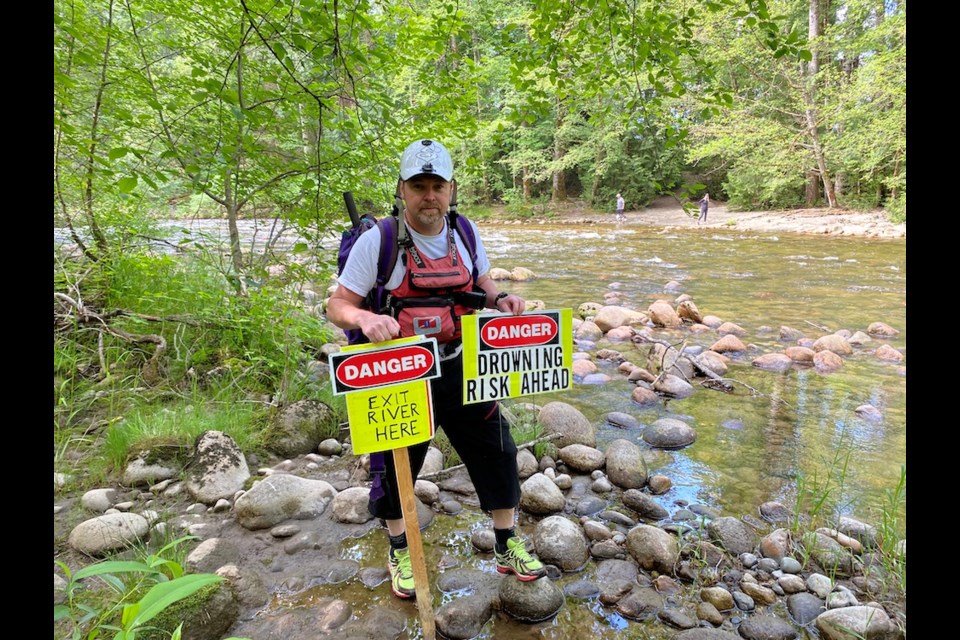A former swift-water rescue instructor is raising the alarm about fallen logs in the Coquitlam River that could pose a danger to tubers.
Richard Joy says two large trees have fallen into the river in two spots, including one close to the popular Ginger Beach in Port Coquitlam.
He said the trees should be removed to avoid a potential drowning.
"Fallen trees across the river can be a really dangerous situation for anyone tubing the river," Joy told the Tri-City News.
"The power in the river can be very deceptive in places. Tubers often aren’t aware of this until the force of the water either pins them against the tree or forces them underwater, where clothing can get snagged on branches."
Teen trapped
In one recent incident, a teenager who was floating down the river became entrapped in a tree 50 metres downstream of the McAllister bridge in Port Coquitlam.
"They needed assistance from others to escape. It’s just under the water, so is hard to see from upstream."
Further upstream, near Dunkirk Avenue on the Coquitlam side and near River Springs on the Port Coquitlam side, an even larger tree has fallen across the river.
It spans the entire width of the river near Ginger Beach, where children often play and there's a rope spring.
"Tubing is great fun but people aren't aware of the dangers," said Joy, who has contacted both the cities of Coquitlam and Port Coquitlam about the trees.
On Wednesday (May 24), Joy suited up in safety gear to enter the river to remove branches from the tree and wrap it in caution tape.
He also made signs to alert tubers to the danger, and to urge them to get out of the river, if they enter the water upstream of the tree from a small beach on the Coquitlam side.
"While the river isn't usually very deep there in the summer, the water flow is fast and deceptively strong. There are multiple snagging hazards on this tree and only about 18 inches of space underneath. It would be easy for a person to get forced underneath the tree and be held underwater," said Joy.
"People should get out well before this and walk around it until it's removed."
Joy said he would like to see the cities of Coquitlam and Port Coquitlam work together on removing the trees.
Kathy Reinheimer, Coquitlam's manager of parks and facilities, said plans are to assess the tree as a possible safety hazard. But if it's deemed to be a danger it won't be removed until late summer, during a time when salmon are less active in the river (also called the fisheries window).
"In general, we really caution tubers and anyone out in nature to be alert and pay attention to unexpected things, the water flows can vary considerably," she said.
While the city monitors dangerous trees that could fall on a road or trail; woody debris that falls in a river, creek or stream is usually left to create salmon habitat, Reinheimer added.
"As long as there is no person or dog who would be it hit by it, we would let nature take its course," Reinheimer said.
"Typically we wouldn’t look at a river as a target unless it's an unusually large or heavy tree," she said.
But Joy would like to see the tree upstream of the popular hangout Ginger Beach dealt with sooner. He recommends that at the very least sections be chopped out to allow free passage.
He said he's toured North America to talk about swift water safety and he's found that most jurisdictions are set up to monitor and promote safety in local waterways.
That doesn't seem to be the case along the Coquitlam River, he said.
"I'm concerned that there doesn’t seem to be a response system in place to remove safety hazards in the river," said Joy.
With more people moving to the area and seeking out cool places to get out of the heat, Joy expects more people to frequent the Coquitlam River.
"It's like a playground," Joy said, " but it's not without its hazards."





